
As 2017 came to a close, FDA released its annual priority list for the new year, as well as previously-issued final guidance documents for which the Center for Devices and Radiological Health (CDRH) is accepting feedback as part of its retrospective review.
In our interpretation, this 2018 priority list includes guidance documents that FDA intends to publish (A-list) and a second group that the agency hopes to publish (B-list). The list also includes guidances issued in 2008, 1998, 1988 and 1978 that are now subject for review and feedback.
Topics relevant to orthopaedic device manufacturers are listed below.
A-list
Final Guidance Topics
- Unique Device Identification: Policy Regarding Compliance Dates of Class I and Unclassified Devices
- Appropriate Use of Voluntary Consensus Standards in Premarket Submissions for Medical Devices
Draft Guidance Topics
- Export Certificates
- 510(k) Third Party Review Program
- Expansion of the Abbreviated 510(k) Program: Demonstrating Substantial Equivalence through Performance Criteria (we expand on this below)
- The Application of Acceptable Uncertainty to Support Marketing Authorization Decisions for Medical Devices
B-list
Final Guidance Topics
- Human Factors List of High Priority Devices
- Benefit-Risk Factors to Consider When Determining Substantial Equivalence in Premarket Notifications [510(k)] with Different Technological Characteristics
Draft Guidance Topics
- Premarket Submissions for Patient Matched Guides to Orthopedic Implants
The complete list, as well as the full list of the Agency’s 2018 priorities, can be read in full here.
Of particular note on the A-list Draft Guidance is the creation of a voluntary, alternative 510(k) pathway. First announced in September 2017, this fast-track method is designed for devices that may not meet the criteria for clearance under FDA’s existing 510(k) pathway. The alternative pathway will be available for pre-specified categories of “mature” and “well-understood” devices, or those for which FDA is able to identify safety and performance criteria of existing devices.
Under current law, a product cleared under the 510(k) pathway must show substantial equivalence in materials and intended use to a predicate—an existing legally marketed device. The new proposal would remove the need to test a new product against a specific predicate. The benchmark would instead become certain technical standards identified by FDA that would, in effect, serve as a proxy for the predicate.
The proposal is part of a broader effort by FDA to reduce the amount of clinical evidence required for medical device approvals. If implemented, it could save device companies millions of dollars and shave years off development times.
FDA plans to release further details in non-binding guidance for industry early this year.
Like you, I often find it difficult to navigate through FDA’s language and wording. Each Draft and Final Guidance announcement brings with it a host of questions and confusion. If this alternative 510(k) pathway comes to fruition, we expect to field questions from industry as companies that attempt it experience both successes and failures.
Rob Meyer is ORTHOWORLD’s Senior Editor. Please send comments on this article to Carolyn LaWell.




